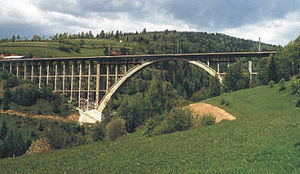Caracau Viaduct
Coordinates: 46 ° 31 ′ 28 ″ N , 25 ° 52 ′ 20 ″ E
| Caracau Viaduct | ||
|---|---|---|
| overall length | 264 m | |
| Longest span | 100 m | |
| start of building | 1895 | |
| completion | 1897, 1917, 1945, 1946 | |
| location | ||
|
|
||
The Caracău Viaduct (also Karako Viaduct , Romanian Viaductul Caracău , Hungarian Karakó völgyhid ) is a railway bridge in the Romanian district of Harghita in eastern Transylvania on the Sfântu Gheorghe – Siculeni – Adjud railway line , which in the Ciumani tunnel at 1012 Main ridge of the Eastern Carpathians crossed below. The viaduct is located between the stations Caracău (km 134) and Livezi Ciuc (km 130.94).
The Caracau Viaduct is considered to be the largest concrete arch bridge in Romania.
prehistory
In the 19th century, Transylvania was part of Austria-Hungary . On what was then known as the Székler Railway, the border with Romania ran east of the main ridge of the Eastern Carpathians near Ghimeș ( Gyimesbükk in Hungarian ). The viaduct west of the main ridge therefore belonged to the section from Sfântu Gheorghe / Sepsiszentgyörgy / Sankt Georgen via Miercurea Ciuc / Csíkszereda / Szeklerburg and Siculeni / Madéfalva to Ghimeș / Gyimesbükkva, built by the Royal Hungarian State Railways (MÁV) .
Truss Bridge (1897)
The first viaduct over the Caracău Valley was a steel truss bridge, planned by MÁV engineers and built between 1895 and 1897, with a 102.22 m long fish-belly girder over the main opening and two 51.36 m long parallel- chorded truss girders over the side openings. The connection to the track was made by one or three stone round arches with 8 m wide openings. The two pillars were also made of natural stone that came from quarries near the bridge. The masonry work was carried out by Italian migrant workers between April and October 1896. The steel girders were erected within 72 days and completed in December 1876. The tracks ran at a height of 64 m above the valley floor.
Temporary Bridge (1917)
In the First World War Romania was initially more inclined towards the Central Powers, but was in fact neutral. In 1916, however, it entered the war on the side of the Entente. In order to delay the entry of the Romanian troops, Hungarian troops blew up several bridges on the railway line, especially the main girder of the viaduct over the Caracau Valley.
After the counter-offensive by the Central Powers, the bridge, which is important for supplies, had to be rebuilt. A makeshift bridge with a Roth-Waagner bridge device was planned . In the 102 m wide main opening, two 60 m high pillars made of Roth-Waagner elements were to be erected and bridged with Roth-Waagner girders. When erecting the first pillar, it became apparent that the subsoil for the second pillar was insufficiently stable. For this reason, one pillar was reinforced and two-story screwed Roth-Waagner girders 69 m and around 30 m long were installed in cantilever over the two openings . Construction began on December 8, 1916 and was completed on March 27, 1917 despite the harsh winter. A total of 840 t of steel was used.
As in other cases, the Roth-Waagner temporary bridge with its screw connections was not replaced by a riveted structure after the war . It did service until it was blown up and completely destroyed by German troops retreating from the Red Army in 1944 during World War II .
Temporary bridge (1945)
Immediately after the Wehrmacht had withdrawn, the Romanians built a wooden scaffolding pillar viaduct that filled the entire valley section within 70 days , and traffic could be resumed on February 12, 1945.
Concrete Arch Bridge (1946)
At the same time, a permanent bridge was put out to tender. A 264 long arch bridge was awarded the contract. Construction lasted a year and two months and was completed on July 12, 1946.
The reinforced concrete arch has a span of 100 m. It is 6.5 m wide at the top and 10.0 m wide at the fighters . The arch has a hollow cross-section; its construction height is 2.5 m at the top and increases to 4.8 m at the fighters. The track girder is elevated by rows of four narrow supports each, which are stiffened at regular intervals by longitudinal and cross members. The bridge is designed for two tracks, but has only ever had one track. During renovation work in the nineties, the track was laid in the middle.
The viaduct survived the 1977 earthquake unscathed.
Web links
- Viaduct over the Karako Valley on austria-forum.org
- Imre Incze: Viaductul Caracău: Blog from February 28, 2014 on railnetromania.blogspot.com
- O excursie la Viaductul Caracau. Blog from September 16, 2009 on Forumul Vehiculelor
Individual evidence
- ↑ László Kovács (Ed.): History of the Hungarian Railways 1846-2000. Hungarian State Railways Publishing House, Budapest 2000, p. 166
- ↑ László Kovács (Ed.): History of the Hungarian Railways 1846-2000. Hungarian State Railways Publishing House, Budapest 2000, p. 172
- ↑ a b c d Imre Incze: Viaductul Caracău: Blog from February 28, 2014 on railnetromania.blogspot.com

